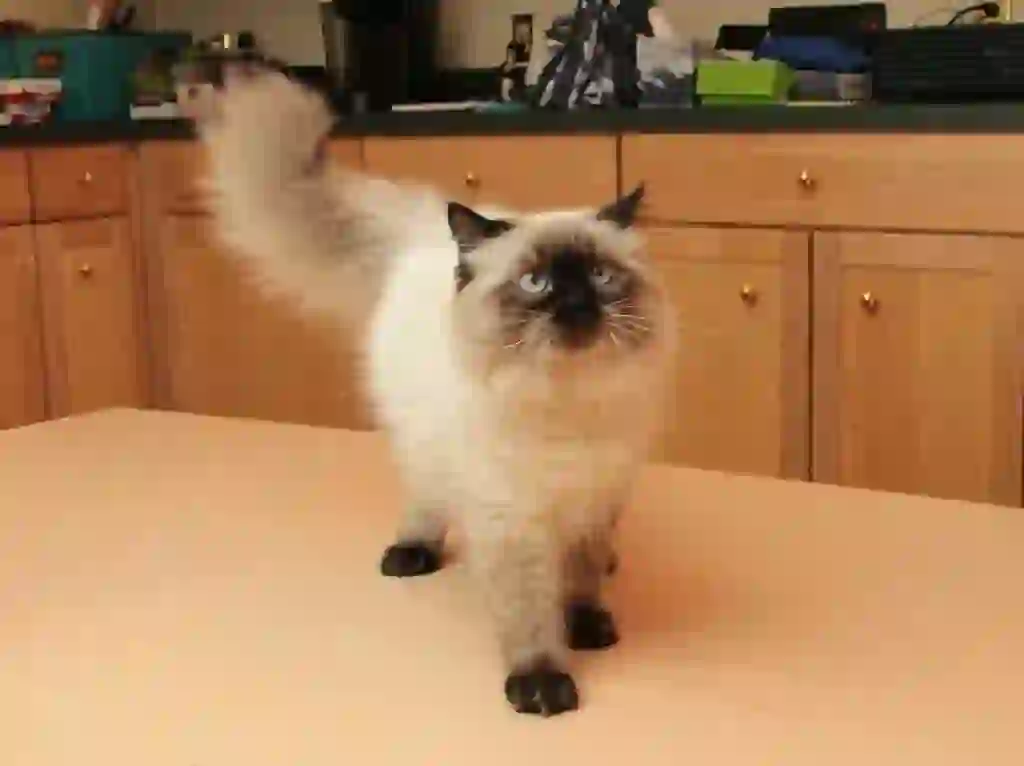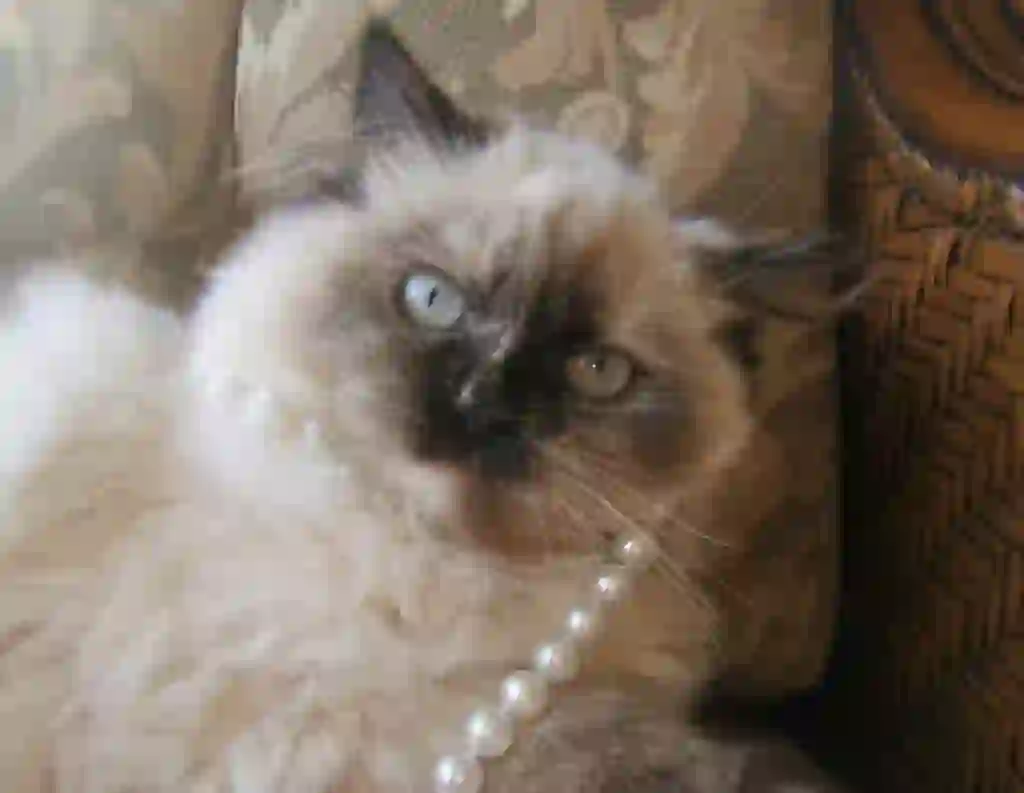
Himalayan
Himalayan
Himalayan
Hey, this animal looks like a raccoon! And it’s fluffy! No, no, that’s a Himalayan cat. By the way, there is also a Himalayan breed of rabbit, but it seems that the rabbit was discovered first. The Himalayan has a similar appearance to the Persian cat, but it has a unique and elegant atmosphere that sets it apart from the Persian. Would you like to take a peek at the little-known secrets of the Himalayan?
Himalayan Basic Infomation

Country of origin United Kingdom, and USA.
Weight male: 3-5.5kg female: 3-5kg.
The Himalayan cat is said to have been created by combining the best features of the Persian and Siamese cats in an effort to produce an even better cat.
The earliest concept is believed to have originated in 1924 with a researcher living in Sweden, but at that time, they struggled with breeding and had difficulty achieving success. Breeders in the United Kingdom and the United States, upon hearing this story, also attempted to develop the breed in their respective countries.
In the United Kingdom, there already existed a crossbreed of Siamese and Persian cats, but it was not officially recognized as a Himalayan and was referred to as “Khemer.”
On the other hand, in the United States, long-haired black cats were crossed with Siamese cats, and then Persian cats were introduced in subsequent steps to create a cat that closely resembles the present-day Himalayan. This breed was known as “Debutante” at the time. Although it was recognized by TICA and CFA in 1957, CFA registered it as a “variant of Persian” rather than an independent breed of Himalayan.
To be registered as a Himalayan, it was necessary for cats with the same characteristics to be maintained for at least three generations. However, the Debutante at that time struggled to stabilize the characteristics of a Himalayan.
As a result of repeated breeding improvements, by the 1970s, a cat that closely resembled the ideal Himalayan was finally created. However, it is still referred to as an “unfinished cat,” so breeding improvements continue to this day.
Himalayan Q&A

Where does the Himalayan name come from?
The Himalayan cat was named after the color distribution on its face, ears, legs, and tail, which resembles that of a rabbit called the “Himalayan.”

What are the color variations of the Himalayan?
Blue, black, fawn, red, cream, lilac, and chocolate are the colors available for Himalayan cats.
・Pointed. Color appears on parts of the body such as the head, ears, legs, and tail.
Only sapphire blue.
Himalayans are long-haired cats only.

What does the Himalayan look like?
The Himalayan cat has a dome-shaped, broad head with big round eyes. It has small, rounded ears and a cobby body type. The legs are relatively short, and it has an overall sturdy and robust physique. Another characteristic feature is its coat, which has a silky texture.
Interestingly, even among Himalayan cats, there are two different facial types. The first one is called the “Doll Face (Traditional).” This type has a well-defined nose line and a cute face similar to that of a typical cat. Doll Face Himalayans are more common in Japan.
The second one is the “Extreme Face.” The distinctive feature of this type is that its nose is flattened, somewhat resembling the appearance of a Persian cat. It can be described as having a somewhat “cute but grumpy” look. Extreme Face Himalayans are more commonly seen overseas.
By the way, in Japan, the Extreme Face Himalayans are more popular.

Why do the Himalayan have two different faces?
As mentioned earlier, there are “Doll Face (Traditional)” and “Extreme Face” types of Himalayan cats. These are unique characteristics not found in other cats.
The exact reason is still unknown, but if we were to speculate, it is likely because the Himalayan breed itself is still incomplete and undergoing improvements.

How much does it cost to buy a Himalayan?
When keeping animals as pets, it is necessary to comply with the laws established by each country. This time, I will talk about keeping Himalayans at home in Japan. The cost of purchasing from a breeder or cattery is around 150,000 to 300,000 yen. The advantage here is that you can check points such as the environment in which they grew up and what kind of parents they have. Also, since the breeder's personality affects the level of trust, I recommend visiting once if you find your favorite kitten.
At a pet shop, the price is usually around 200,000 to 300,000 yen. When comparing in this way, purchasing from a breeder seems more affordable.
However, if you purchase from a "cattery," which is the highest qualification for breeders, it may be more expensive than pet shops or breeders. Since catteries require certification from "CAF" and "TICA," which are pedigree issuing organizations, breeders with this qualification are highly trusted and can be said to have added value. The reason for the high price is that it serves as proof of trust.
In addition to that, there are several conditions that cause price variations:
・Being a kitten. ・Having excellent pedigree. ・Having rare colors or patterns. ・Having an extreme face (in Japan).
Although there are other conditions, it seems that especially meeting the above conditions makes the price higher.

I want to know more about the character of the Himalayan!
The Himalayan cat is gentle and calm, which may be due to its Persian influence. It can spend time alone in a relaxed manner, so it seems to be fine with staying at home alone. It doesn’t meow much, but it may meow when it’s time to eat.
Although the Himalayan cat is gentle, it still has the instincts of a cat. When it finds a moving toy or a toy it likes, it moves around actively. It also jumps at the cat teaser that the owner moves, but sometimes it goes to other places as if nothing had happened. However, this is not only true for Himalayan cats but for all cats, so Himalayan cats are not particularly prone to boredom.
Himalayan cats are intelligent and will obey if trained. They are recommended for those who are new to cat ownership. They usually take things at their own pace, but sometimes they come to their owners for affection. They are recommended for those who want a cat that can communicate with them without being too clingy.

What diseases are the Himalayan susceptible to?
Himalayan cats are prone to "polycystic kidney disease," "lower urinary tract disease," and "epiphora."
Polycystic kidney disease is a condition in which many cysts form, and in the worst case, it can cause "renal failure." Since there is still no prevention method for this disease, it is important to receive regular health checkups. The incidence of this disease is high in elderly cats, so caution is required. However, if detected early, the progression of the disease can be slowed down with symptomatic treatment.
Cats have a habit of not drinking a lot of water due to their ancient heritage. As a result, they often develop urinary tract diseases because their kidneys are under stress.
Specifically, there are "urinary tract stones" and "cystitis," in which stones made in the kidneys become clogged in the urethra and other tissues in the body are damaged. If you notice symptoms such as a decrease in the number of times you go to the bathroom, blood in your urine, or a change in the color of your urine, please visit a hospital as soon as possible.
Although it is preventable by being careful about your daily diet and the number of times you give water, there are cases where you may still get sick no matter how careful you are. Therefore, it is recommended that you receive regular health checkups if possible.
Epiphora is a condition where tears accumulate around the eyes and cause inflammation around the eyes. Since Himalayan cats have low noses, their nasolacrimal ducts are short, making them more prone to tears than other cats. If you notice any eye discharge, please wipe it away when you notice it.

What is the lifespan of the Himalayans?
It is said that the lifespan of a Himalayan cat is 12 to 15 years. The average lifespan of a cat in general is 12 to 16 years, so it can be considered average.

Would you like to become a part of the 'Animalbook.jp'?
Turn your knowledge into Q&A and share it with the world. ※Publication will be activated after purchase. Let's share information together!
Himalayan Type of List

- Himalayan
Information
Congratulations! You are the first commenter!

Create Your Favorite List!
Himalayan
Save the animals you love! Build your own list to quickly revisit your favorites later.

Would you like to leave a comment?
※Please note: This is for the purchase of rights to post comments within the article.
Find Your Favorites!
Our shop offers a unique and attractive selection of goods themed around various animals.
Himalayan References

- まるごとわかる猫種大図鑑 監修:CFA公認審査員 早田由貴子
- 世界中で愛される美しすぎる猫図鑑 監修 今泉忠明
- 猫との暮らし大百科 https://www.anicom-sompo.co.jp/nekonoshiori/
- みんなの猫図鑑 https://www.min-nekozukan.com/
- Pet Smile news forネコちゃん http://psnews.jp/cat/
- 子猫のへや https://www.konekono-heya.com/sitemap.html
- ねこちゃんホンポ https://nekochan.jp/
- 公益社団法人 埼玉県獣医師会 https://www.saitama-vma.org/topics/
Himalayan Introduction of media used

出典:https://pixabay.com/images/id-1353029/

出典:https://commons.wikimedia.org/wiki/File:Himalayan_Cat.jpg

出典:https://www.pexels.com/ja-jp/photo/205975/

Help Enrich Our Animalbook.jp with Your Media!
We are constantly looking to expand and enrich our Animalbook.jp with amazing photos and videos of animals. If you have any media that you'd like to share, please contribute and help us showcase the beauty and diversity of the animal kingdom. Your submissions will be credited and featured in our encyclopedia, reaching a wide audience of animal lovers.



















